Joséphine de Beauharnais: Patron of the Arts
Joséphine de Beauharnais was born in Martinique as Marie Josèphe Rose Tascher de La Pagerie. She evolved into the sophisticated and cultured...
Maya M. Tola 20 May 2024
Social gatherings have consistently inspired artists across history, enabling them to encapsulate the spirit of diverse eras, cultures, and social dynamics. Art has skillfully depicted these gatherings in many styles and contexts, from festive celebrations and grand galas to exclusive soirées and contemporary get-togethers. Thus prompting a contemplation of the intricate tapestry of human interaction. Let’s explore a selection of these scenic gatherings immortalized on canvas.
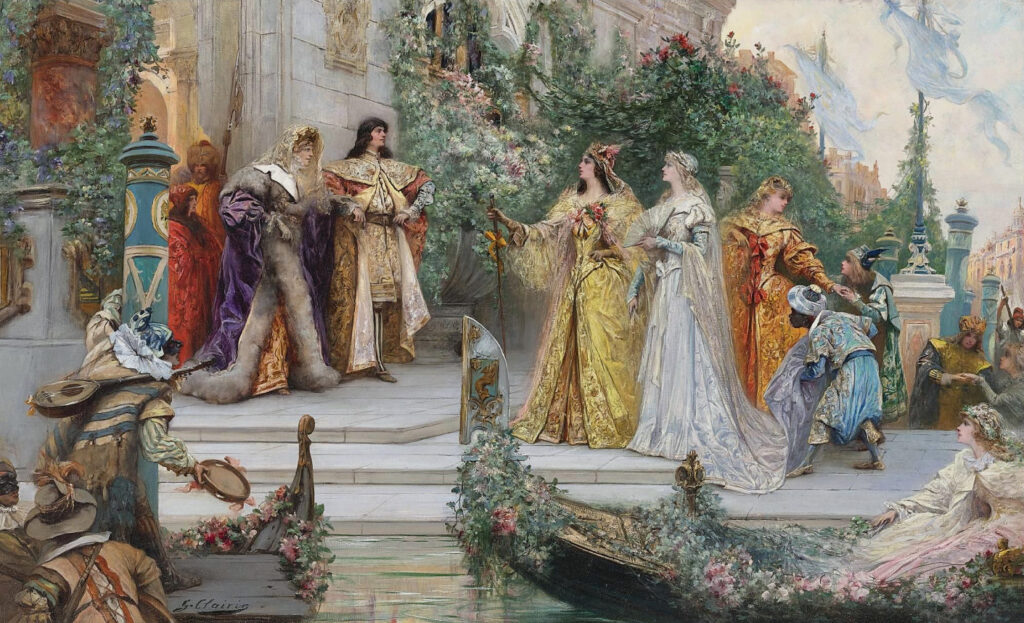
Party in Art: Georges Jules Victor Clairin, The Arrival of the Guests, Venice, ca. 1900s. Photo via Wikimedia Commons (public domain).
Parisian painter Georges Jules Victor Clairin was trained under noted Orientalists such as Jean-Léon Gérôme and Alexandre Cabanel. His works are distinguished by their vibrant colors, intricate details, and exotic subject matter, showcasing his mastery of painting. Clairin exhibited regularly at the prestigious Paris Salon, earning numerous awards and honors throughout his career. Although he was renowned for his depictions of Africa and the Middle East, The Arrival of the Guests, Venice represents a deviation from his chosen subject matter.
In this painting, Clairin captures an upscale Venetian gathering with rich and joyous colors, depicting the arrival of guests at a grand soirée. The scene is filled with excitement and anticipation, highlighted by floral drapes adorning the buildings and gondolas in view. Attendees, dressed in bright attire, are warmly greeted by elegantly dressed hosts. Through his vibrant brushstrokes, Clairin skillfully conveys the energy and atmosphere of the gathering, creating a captivating portrayal of Venetian life.
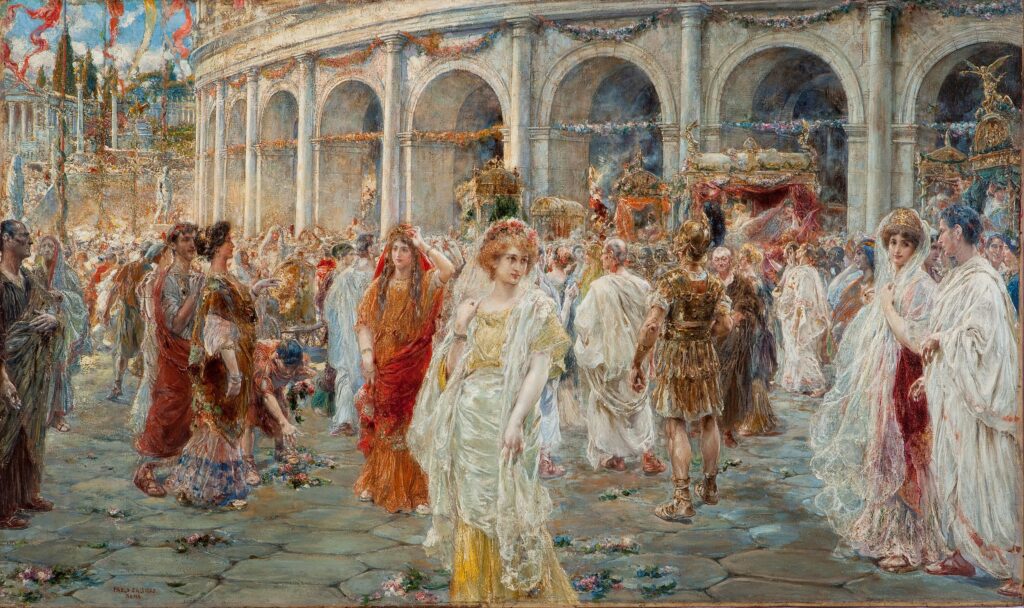
Party in Art: Juan Pablo Salinas Teruel, The Roman Festivals of the Colosseum (As Festas Romanas do Coliseu), ca. 1900s, Pinacoteca do Estado de São Paulo, São Paulo, Brazil.
Juan Pablo Salinas Teruel, a Madrid-born artist, moved to Rome in the 19th century and found his place among a community of Spanish artists in the Eternal City. Renowned for his meticulous attention to intricate details, Salinas Teruel’s art skillfully captured the essence of costume and the festive ambiance, vividly portrayed in this painting along streets strewn with flowers.
Within this canvas, he presents a captivating scene of idealized revelry, skillfully placing it against the iconic backdrop of the Colosseum. Despite the multitude of glamourous figures on the canvas, the artist has drawn attention to the two female figures at the center of the foreground. The painting exudes the Spring season, infusing the gathering with a vivid and lively atmosphere.
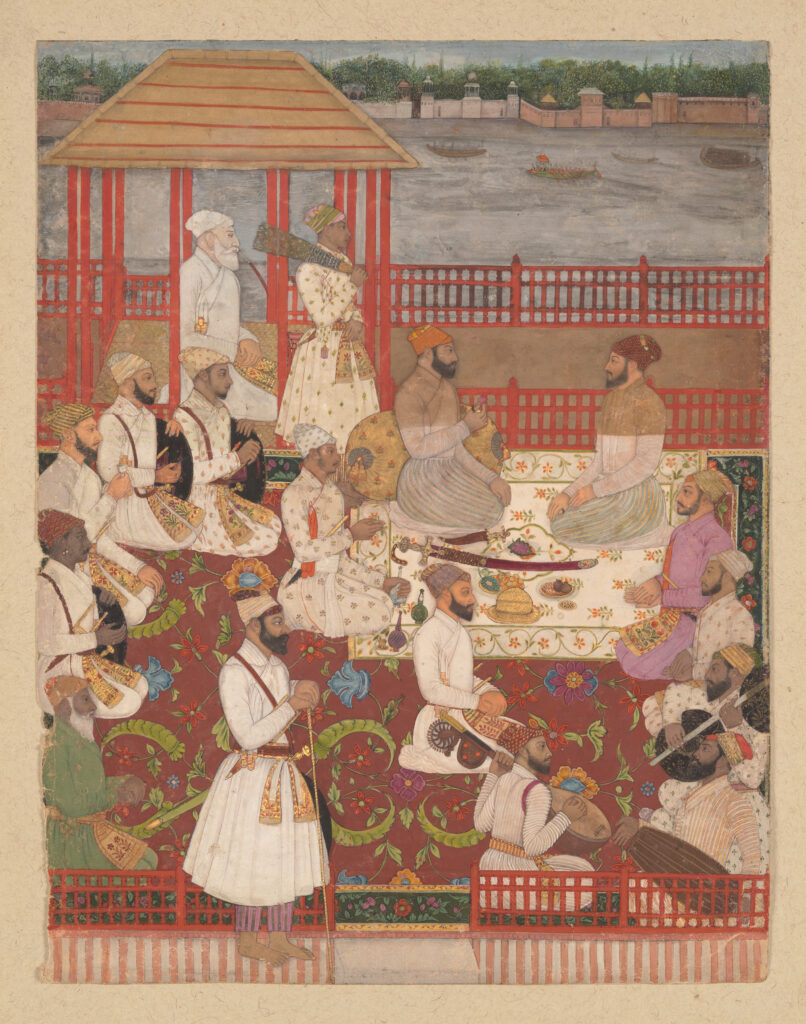
Party in Art: Music Party on a Riverside Terrace, ca. 1670. The Metropolitan Museum of Art, New York City, NY, USA.
This gathering appears to be subdued at first glance, but upon a closer look, it unveils a vibrant albeit idealized celebration in Medieval India. It showcases an ultimate display of the opulence of Mughal courts. Completed during Aurangzeb’s reign, this painting follows the typical style of Mughal artworks, with several figures seated on an ornate Persian rug within a grand Mughal garden.
At its center, the host is reclined on a bolster entertaining his important guest seated across from him. Grim-faced attendants punctuate the scene, while musicians in the lower right corner remind us of the patronage of artists by noblemen of this era. Through meticulous detail, the court artists responsible for this painting have immortalized the rigid order and nuanced splendor of this opulent courtly setting.
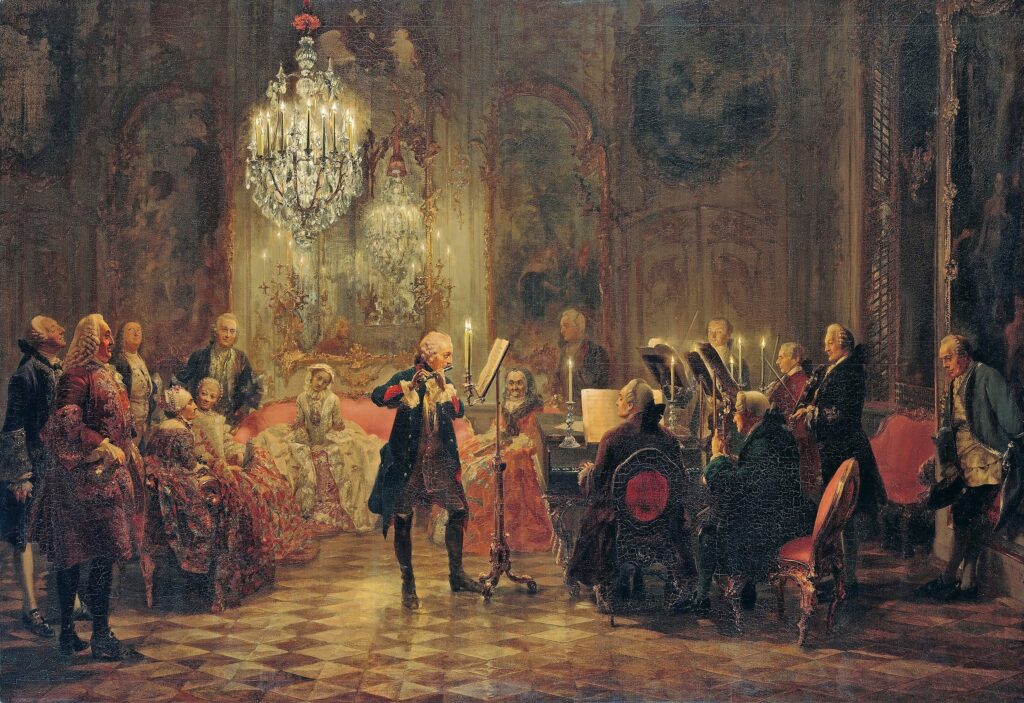
Party in Art: Adolph Menzel, Frederick the Great Playing the Flute at Sanssouci, ca. 1852, Alte Nationalgalerie, Berlin, Germany. Photo via Wikimedia Commons (public domain).
Adolph Menzel was a prominent German artist known for his influential contributions to the Realism movement during the 19th century. Renowned for his detailed and accurate depictions of daily life and historical events, Menzel’s paintings were praised for their incredible depth and technical proficiency. They effectively captured the essence of the evolving society during the Industrial Revolution in Germany.
One of Adolph Menzel’s notable works presents the 19th-century King of Prussia, Frederick the Great, playing the flute during an evening concert at his summer palace, Sanssouci. Candles scatter the warm glow across this Rococo masterpiece, casting Frederick into the spotlight among enthralled onlookers.
What adds a surprising dimension to this painting is that Menzel lived a century after the depicted historical figure, showcasing his ability to transport viewers to different eras through his mastery.
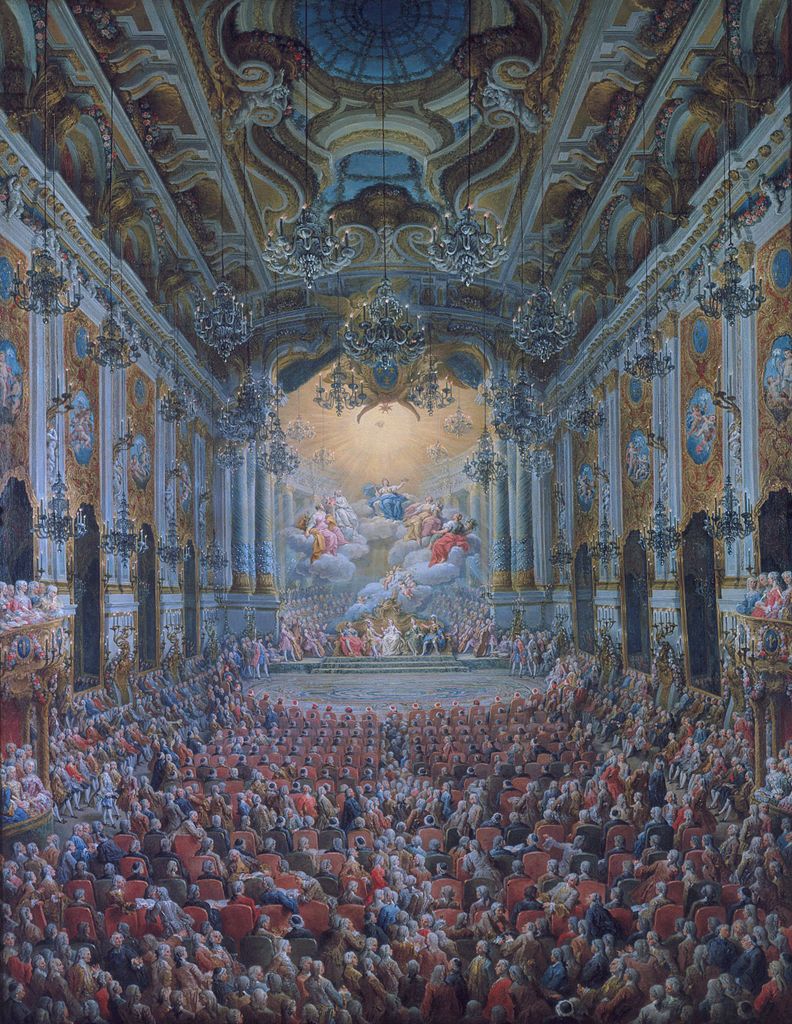
Party in Art: Giovanni Paolo Panini, A Concert, ca. 1751. Photo via Wikimedia Commons.
Prolific Italian painter, architect, and Opera stage designer Giovanni Paolo Panini emerged in the 17th century. He was renowned for his highly detailed and imaginative architectural views and cityscapes. His works depicted panoramic views, capturing the grandeur of ancient ruins and historical landmarks.
Particularly adept at combining actual and imagined elements, he created compositions that offered a vivid and idealized vision of the city, showcasing the architectural marvels of Rome. In addition to his architectural works, the artist painted captivating historical and mythological scenes.
This notable work synthesizes his skills as both an artist and a set designer, depicting the climax of a celebration set in a grand room. This room is brightly illuminated with torches and lamps and adorned with mirrors and rich tapestries. Elegantly dressed musicians and attendees filled the scene, emphasizing the vibrancy of this sophisticated cultural gathering. On stage, three men and two women portray mythological gods, while above them, five young women seated on clouds represent symbols of Virtues.
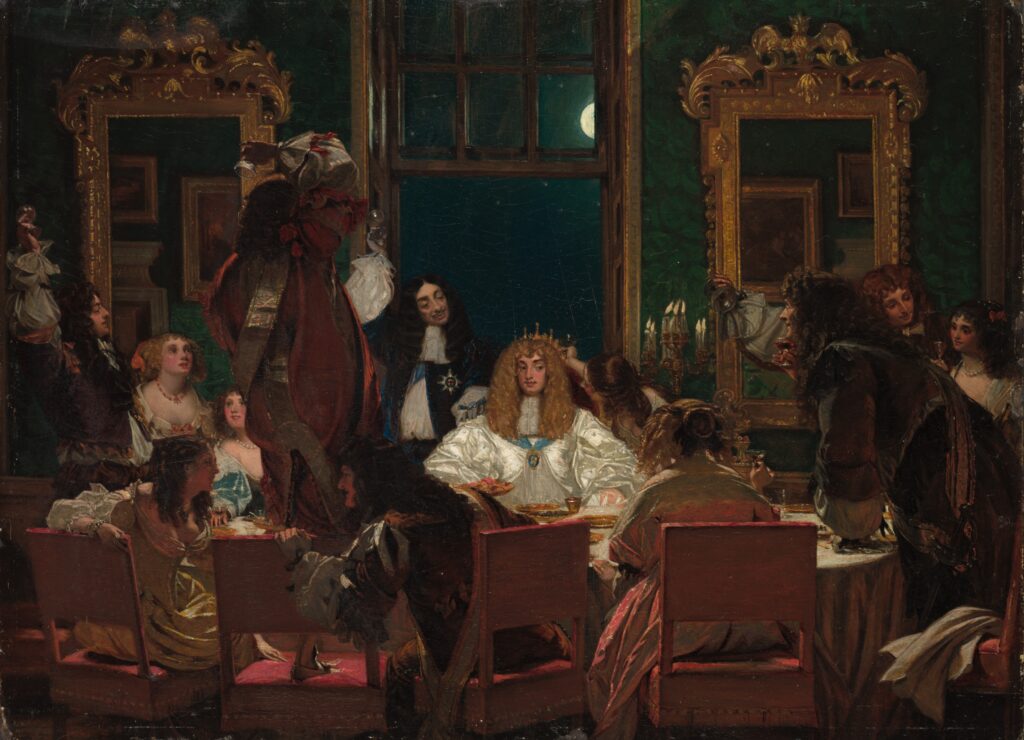
Party in Art: Augustus Leopold Egg, The Life of Buckingham, ca. 1855, The Cleveland Museum of Art, Cleveland, OH, USA.
Augustus Leopold Egg, a Victorian-era English artist and a notable member of the Pre-Raphaelite Brotherhood, played a significant role in the avant-garde movement. It sought to reform and challenge established artistic conventions. His works, known for their detailed, vibrant, and emotionally charged nature, often delved into scenes with moral and social overtones. This reflected the Victorian fascination with narratives carrying moral lessons. Despite his short career, Egg left a lasting impact on the art world before passing away at 47.
This painting, titled “The Life of Buckingham,” portrays a fictional moment in the degenerate and rogue life of George Villiers (1628–1687), the 2nd Duke of Buckingham. The central figure, the Duke, is seated and dressed in white, surrounded by merrymakers and courtesans who fawn over him. This depiction serves as a poignant cautionary tale of excess and sheds light on the consequences of a life characterized by indulgence and moral laxity. Egg’s artistic skill and thematic choices resonate in this work, adding depth to his exploration of Victorian-era societal norms and moral dilemmas.
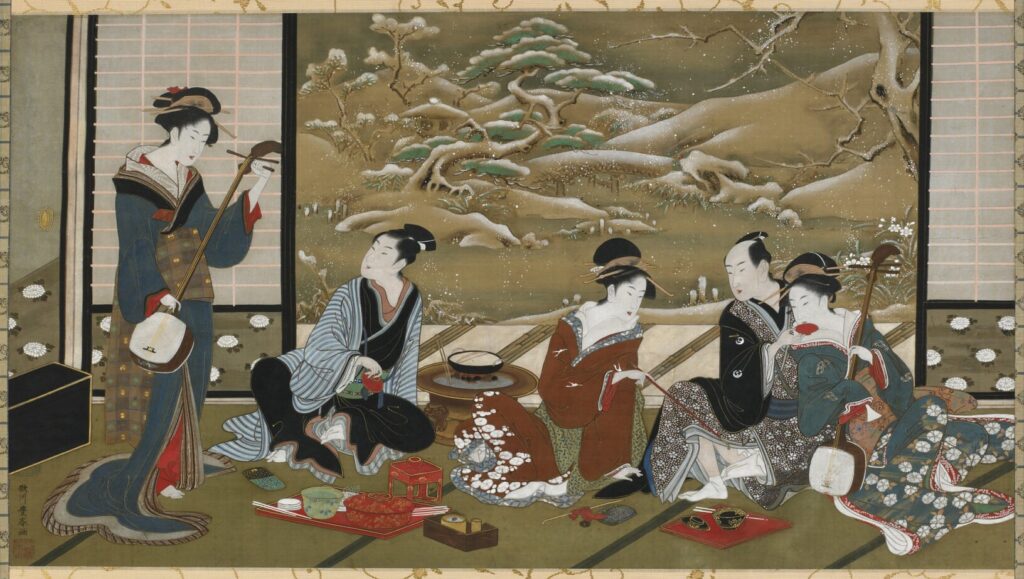
Party in Art: Utagawa Toyoharu, A Winter Party, ca. 1735 to 1814, National Museum of Art at the Smithsonian, Washington, DC, USA.
Utagawa Toyoharu was an esteemed ukiyo-e artist active in Japan in the late eighteenth and early nineteenth centuries. He is renowned as the founder of the Utagawa school and for his vibrant scroll paintings (kakemono).
This vibrant painting, “A Winter Party,” captures a casual yet elegant gathering against a snow-covered landscape. The attendees have gathered indoors, seemingly oblivious to the inclement weather outside. The relaxed revelry is evident as the figures dine and drink in tasteful lacquerware, with the sounds of the three-stringed shamisen undoubtedly adding a touch of melodic sophistication to the scene.
This artwork celebrates the contrast between the frosty exterior and the warmth and vibrancy of the indoor gathering while also offering a glimpse into the sophisticated social customs of the contemporary Edo period.
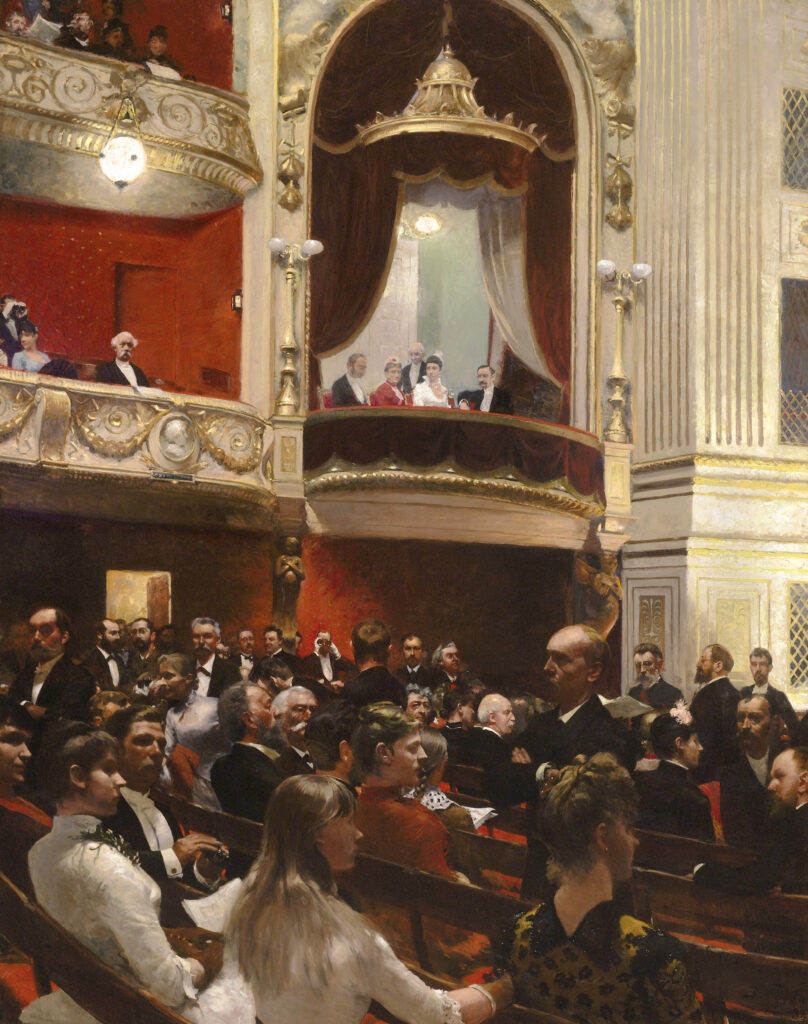
Party in Art: Paul Gustav Fischer, An Evening at the Royal Theatre, ca. 1887 -1888. Photo via Wikimedia Commons (public domain).
Paul Gustav Fischer, a Danish painter associated with the Skagen painters of northern Denmark, was renowned for masterful renderings of urban life with great detail and realism. His works often portrayed human figures engaged in various activities, particularly everyday scenes and social gatherings.
This painting is set at the elite Royal Theatre in Copenhagen, the oldest continuously operating theatre in the world, recognizable by its ornate interior. It exudes Fischer’s great sense of depth, showcasing the elegant and cultural subjects at the Royal Theatre.
Fisher’s works are distinguishable from those of his contemporaries. His distinctive touch of realism infuses his figures with a sense of life and individuality. Notably, in the top center background, the Danish Royal Family observes the gathering from its private balcony, adding another layer of significance to the scene.
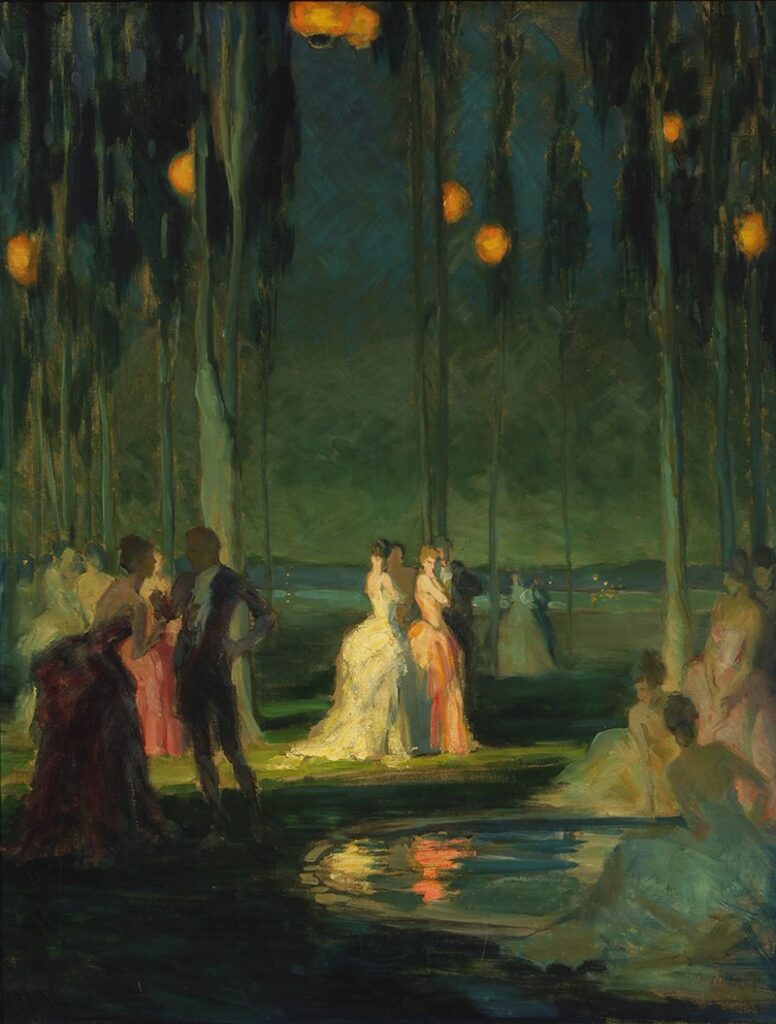
Party in Art: Aloys Bohnen, Summer Night, ca. 1925, Bowers Museum, Santa Ana, CA, United States.
Born in Minnesota to Dutch immigrants, Aloys Bohnen embarked westward, relocating to Southern California in 1922. There, he flourished as a successful muralist, contributed to the world of film, and eventually embraced the role of an art teacher.
This warm painting by Bohnen depicts a formal black-tie event, with men in tuxedos and women in elegant evening gowns gathered within a eucalyptus grove. The scene is bathed in the warm glow of orange paper lanterns with reflections in the tidepools, creating a warm atmosphere of quiet sophistication.
Bohnen’s artistic approach prioritizes capturing the essence of the glamorous gathering through intricate details. The central focus is the woman under the spotlight, elegantly dressed in coral. Her angled gaze suggests a contemplative connection with the viewer, adding a layer of intrigue to the composition.
However, a subtle hint of drama unfolds beyond the spotlight in the left foreground. A couple seems to be caught in mid-argument or, at the very least, engaged in a highly animated conversation, contributing an element of narrative depth.
DailyArt Magazine needs your support. Every contribution, however big or small, is very valuable for our future. Thanks to it, we will be able to sustain and grow the Magazine. Thank you for your help!